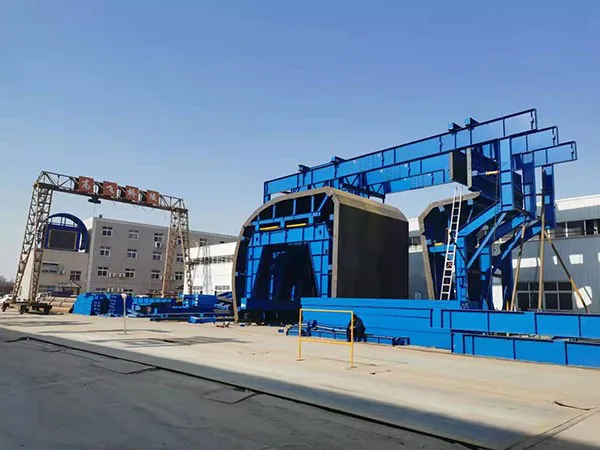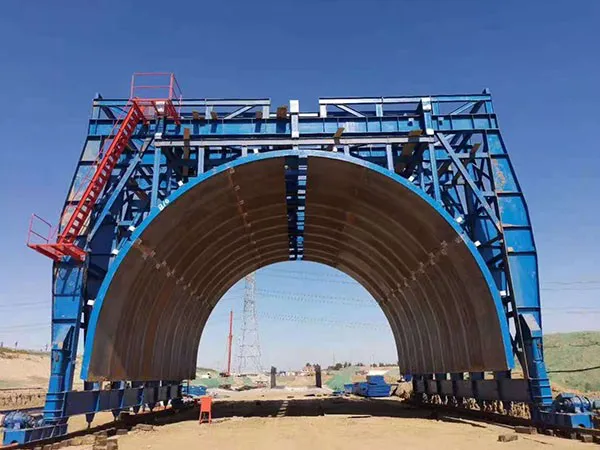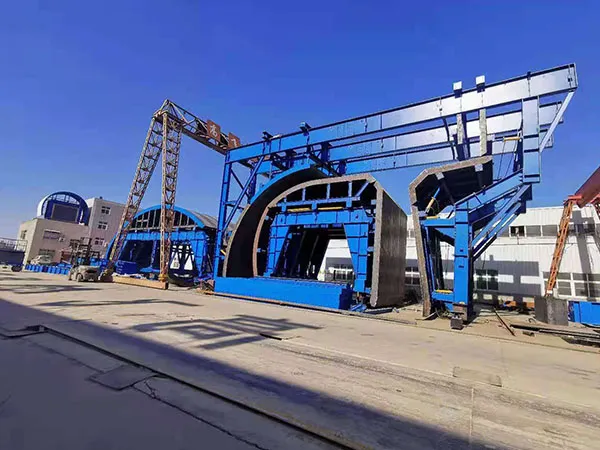A custom steel plug template for tunnel lining refers to specialized steel formwork or molds used in the construction of tunnels. These plugs or templates are crucial for creating the precise shape and dimensions of the tunnel lining, whether it's for in-situ concrete pours or for manufacturing precast concrete segments.

Shaping the Tunnel Lining: The primary function is to define the exact geometry of the tunnel's inner surface. This includes the circular or other specified cross-section, as well as any features like recesses for utilities, grout holes, or connection points for subsequent lining rings.
Ensuring Accuracy and Quality: Steel offers high rigidity and precision, which is essential for achieving a smooth and consistent concrete finish and for ensuring that tunnel segments fit together perfectly.
Durability and Reusability: Custom steel templates are designed for multiple uses, making them cost-effective for long tunnel projects or repeated segment production. They can withstand the pressures of concrete pouring and repeated stripping.
Facilitating Construction: These templates often integrate features that aid the construction process, such as:
Stripping mechanisms: Designs that allow for easy and efficient removal of the formwork once the concrete has cured.
Integrated heating/cooling: For controlling concrete curing times in varying environmental conditions.
Walkways and access points: For workers to safely place rebar, vibrators, and other equipment.
Guidance systems: For alignment during installation of segments or during in-situ pouring.
Precast Segment Manufacturing: For tunnels built with precast concrete segments (common in TBM tunneling), custom steel molds are used in a factory setting to produce each segment with high precision. These segments are then transported to the tunnel site and assembled.
In-situ Concrete Lining: For tunnels where the lining is cast directly in place, large steel formwork systems (often called tunnel forms or shutters) are used. These can be full-circle forms or half-tunnel forms that are joined. They are advanced incrementally as the tunnel progresses.
Design and Fabrication Workflow
Site Survey: A precise 3D laser scan of the opening is performed to capture the exact geometry of the existing lining.
Engineering Design: A structural engineer designs both the concrete plug (including rebar) and the steel formwork. Calculations are made to determine the maximum concrete pressure and ensure the formwork can withstand it with minimal deflection (e.g., < L/360).
CAD/BIM Modeling: The formwork is modeled in 3D software (like Tekla Structures or SolidWorks) to ensure a perfect fit and to create detailed shop drawings.
Fabrication: The steel is cut, welded, and assembled according to the shop drawings by a qualified steel fabricator. Welding must conform to standards like AWS D1.1.
Factory Acceptance Test (FAT): Before shipping to the site, a quality check is performed, including dimensional verification and a trial assembly.
Surface Treatment: The formwork is painted with a durable industrial coating to prevent rust and a non-stick release agent is applied to the face plate before use.

Tunnel Geometry:
Diameter and Cross-section: The most fundamental aspect. Tunnels can be circular, horseshoe-shaped, egg-shaped, or other irregular geometries, each requiring a custom template.
Length of segments/pours: Dictates the size of individual template units.
Taper/Curves: For tunnels that curve, the templates need to be designed to accommodate the changing radius.
Structural Requirements:
Concrete Pressure: The template must be robust enough to withstand the hydrostatic pressure of wet concrete without deformation.
Reinforcement Layout: Provisions for placing rebar cages or steel fibers within the concrete.
Load Bearing: The template itself needs to be structurally sound to support its own weight and any associated equipment or personnel during construction.
Material Properties (Steel):
Type of Steel: High-strength steel is typically used for durability and resistance to wear and tear.
Surface Finish: The concrete-facing surface needs to be extremely smooth to achieve a high-quality finish on the concrete and facilitate easy stripping.
Corrosion Resistance: Especially important in tunnels with groundwater or aggressive environments.
Operational Efficiency:
Ease of Assembly and Disassembly: Modular designs are often preferred for quicker setup and stripping.
Mobility: For in-situ applications, the template often needs to be mounted on a trolley or gantry system for efficient advancement.
Repetitions: The expected number of uses will influence the design and material thickness to ensure longevity.
Integration with other equipment: Compatibility with concrete pumps, vibrators, curing systems, etc.

Wear Resistance: Especially at joints and edges.
Repairability: Design should allow for easy repair of damaged sections.
Cleaning: Surfaces should be easy to clean to prevent concrete buildup.
Cost:
Fabrication Cost: Custom steel work can be expensive, so optimizing the design for manufacturability is important.
Lifespan vs. Initial Cost: Balancing the upfront investment with the expected number of uses and the quality of the final product.
When sourcing a custom steel plug template, it's crucial to work closely with experienced manufacturers who understand the specific demands of tunnel construction and can provide tailored engineering solutions.
Gaofei
Address: 200m east of tulip garden, group 12 of zhangling community, hongshan street office, hongshan town, xigong district, Luoyang
Tel: +8616638856888
Contact: Gaofei Huang
Mobile: +86-18637923976
Phone: 0379-80881719/ 0379-60162687
QQ: 286827457
E-mail: gaofei@gf-bridge-tunnel.com